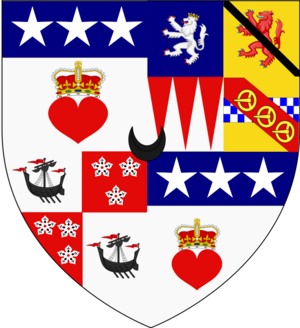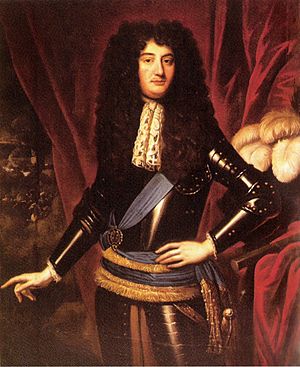Earl of Selkirk facts for kids
The Earl of Selkirk is a special title in Scotland. It has been used since 1646. This title has very unusual and unique rules about who gets to inherit it.
Contents
History of the Selkirk Title
The title was first created on August 14, 1646. It was given to Lord William Douglas. He was the third son of William Douglas, 1st Marquess of Douglas. He also received the title Lord Daer and Shortcleuch at the same time.
On April 29, 1656, the first Earl married Anne Hamilton, 3rd Duchess of Hamilton. After they had two sons, he changed his last name from Douglas to "Hamilton" in 1660. He was also made Duke of Hamilton for his lifetime. This was a common practice in Scotland when a noblewoman with her own title married someone of a lower rank.
How the Title Changed Hands
On October 6, 1688, during the time of King James VII, the Duke of Hamilton gave back his Selkirk titles to the Crown. He kept his Hamilton title. The Selkirk titles were then given to his third son, Charles. Charles became the second Earl of Selkirk. He also changed his last name back to "Douglas."
This meant that the oldest son would inherit the title of Duke of Hamilton. He would use his mother's maiden name, Hamilton. But the younger son would inherit his father's Selkirk titles. He would keep the Douglas name.
The Unique Inheritance Rules
This special arrangement for the Selkirk title had very unusual rules. These rules decided who would inherit the title next:
- The titles would usually go to the male heirs of the first Earl's younger sons. This would happen before the male heirs of his oldest son. His oldest son was already set to inherit the Dukedom of Hamilton.
- If the person who was supposed to inherit the Selkirk title was already the Duke of Hamilton, the Selkirk title would skip them. It would instead go to that Duke's next younger brother.
- If a Duke of Hamilton ever held the Selkirk title, when that Duke died, the Selkirk title would go to his second oldest son. It would not go to his oldest son.
- If the titles went to a younger brother or a younger son under these rules, they would then pass to his male heirs when he died.
- But if the male heirs of such a younger son or brother died out, the title would not go to his own younger brothers. Instead, it would go back to the main family line. Then, the special rules about skipping Dukes and going to second sons would apply again.
These rules were so unusual that a Scottish country dance called "Hamilton House" was created about them!
Later Earls of Selkirk
The second Earl died in 1739 without children. His younger brother, John Hamilton, became the third Earl. John was also the first Earl of Ruglen. He died in 1744. His son had died before him. So, the Earldom of Ruglen went to his daughter.
The Earldom of Selkirk, however, could only be passed to male heirs. So, it went to Dunbar Hamilton. He was the grandson of Lord Basil Hamilton, the sixth son of the first Earl. When Dunbar became the fourth Earl, he also changed his last name to "Douglas."
When the fourth Earl died in 1799, his only living son, Thomas, became the fifth Earl. Thomas was then followed by his only son, Dunbar, as the sixth Earl in 1820.
In 1885, the male heirs from the younger sons of the first Earl ran out. The male heir of the first Earl's oldest son was William Douglas-Hamilton, 12th Duke of Hamilton. But because of the special rules (rule 2 above), the Selkirk titles went to his younger brother, Lord Charles Hamilton. He became the seventh Earl.
When the seventh Earl died in 1886 without marrying, the titles went back to his older brother. Since he had no other younger brothers, he became the eighth Earl. When he died in 1895 without a son, the Dukedom went to his fourth cousin, Alfred Douglas-Hamilton. He became the 13th Duke of Hamilton. Since he also had no brothers, he became the ninth Earl of Selkirk.
When the ninth Earl died in 1940, his oldest son, Douglas Douglas-Hamilton, inherited the Dukedom. But the Earldom of Selkirk went to his second son, Lord George Douglas-Hamilton. This happened because of the special rules (rule 3 above). He became the 10th Earl.
When the 10th Earl died in 1994, he was married but had no children. So, the titles went to his nephew, Lord James Douglas-Hamilton. He was the second son of the 14th Duke of Hamilton. He became the 11th Earl.
At the time he inherited the title, the 11th Earl was a Member of Parliament. He gave up the Selkirk titles so he could stay in the House of Commons. Later, he was made a life peer and became Baron Selkirk of Douglas. He also served in the Scottish Parliament. His heir is John Douglas-Hamilton, Lord Daer.
Earls of Selkirk (1646)
- William Douglas-Hamilton, 1st Earl of Selkirk, jure uxoris 3rd Duke of Hamilton (1634–1694)
- Charles Douglas, 2nd Earl of Selkirk (1663–1739) (younger brother of 4th Duke)
- John Hamilton, 3rd Earl of Selkirk (1664–1744) (younger brother of 2nd Earl)
- Dunbar Douglas, 4th Earl of Selkirk (1722–1799) (grandson of younger brother of 3rd Earl)
- Thomas Douglas, 5th Earl of Selkirk (1771–1820) (son of 4th Earl)
- Dunbar James Douglas, 6th Earl of Selkirk (1809–1885) (son of 5th Earl)
- Charles George Hamilton, 7th Earl of Selkirk (1847–1886) (younger brother of 12th Duke of Hamilton)
- William Alexander Louis Stephen Douglas-Hamilton, 12th Duke of Hamilton, 8th Earl of Selkirk (1845–1895) (older brother of 7th Earl)
- Alfred Douglas Douglas-Hamilton, 13th Duke of Hamilton, 9th Earl of Selkirk (1862–1940) (4th cousin of 12th Duke)
- George Nigel Douglas-Hamilton, 10th Earl of Selkirk (1906–1994) (younger brother of the 14th Duke of Hamilton)
- James Alexander Douglas-Hamilton, 11th Earl of Selkirk (b. 1942) (younger brother of the 15th Duke of Hamilton) (disclaimed 1994)
The person next in line to inherit the title is the former 11th Earl's son, John Andrew Douglas-Hamilton, Lord Daer (born 1978).
Family tree
| Douglas-Hamilton Family Trees: Earls of Arran (Scotland), Dukes of Hamilton, Dukes of Brandon, Earls, and Dukes of Abercorn, and Earls of Selkirk | |||||||||||||||||||||||||||||||||||||||||||||||||||||||||||||||||||||||||||||||||||||||||||||||||||||||||||||||||||||||||||||||||||||||||||||||||||||||||||||||||||||||||||||||||||||||||||||||||||||||||||||||||||||||||||||||||||||||||||||||||||||||||||||||||||||||||||||||||||||||||||||||||||||||||||||||||||||||||||||||||||||||||||||||||||||||||||||||||||||||||||||||||||||||||||||||||||||||||||||||||||||||||||||||||||||||||||||||||||||||||||||||||||||||||||||||||||||||||||||||||||||||||||||||||||||||||||||||||||||||||||||||||||||||||||||||||||||||||||||||||||||||||||||||||||||||||||||||||||||||||||||||||||||||||||||||||||||||||||||||||||||||||||||||||||||||||||||||||||||||||||||||||||||||||||||||||||||||||||||||||||||||||||||||||||||||||||||||||||||||||||||||||||||||||||||||||||||||||||||||||||||||||||||||||||||||||||||||||||||||||||||||||||||||||||||||||||||||||||||||||||||||||||||||||||||||||||||||||||||||||||||||||||||||||||||||||||||||||||||||||||||||||||||||||||||||||||||||||||||||
|---|---|---|---|---|---|---|---|---|---|---|---|---|---|---|---|---|---|---|---|---|---|---|---|---|---|---|---|---|---|---|---|---|---|---|---|---|---|---|---|---|---|---|---|---|---|---|---|---|---|---|---|---|---|---|---|---|---|---|---|---|---|---|---|---|---|---|---|---|---|---|---|---|---|---|---|---|---|---|---|---|---|---|---|---|---|---|---|---|---|---|---|---|---|---|---|---|---|---|---|---|---|---|---|---|---|---|---|---|---|---|---|---|---|---|---|---|---|---|---|---|---|---|---|---|---|---|---|---|---|---|---|---|---|---|---|---|---|---|---|---|---|---|---|---|---|---|---|---|---|---|---|---|---|---|---|---|---|---|---|---|---|---|---|---|---|---|---|---|---|---|---|---|---|---|---|---|---|---|---|---|---|---|---|---|---|---|---|---|---|---|---|---|---|---|---|---|---|---|---|---|---|---|---|---|---|---|---|---|---|---|---|---|---|---|---|---|---|---|---|---|---|---|---|---|---|---|---|---|---|---|---|---|---|---|---|---|---|---|---|---|---|---|---|---|---|---|---|---|---|---|---|---|---|---|---|---|---|---|---|---|---|---|---|---|---|---|---|---|---|---|---|---|---|---|---|---|---|---|---|---|---|---|---|---|---|---|---|---|---|---|---|---|---|---|---|---|---|---|---|---|---|---|---|---|---|---|---|---|---|---|---|---|---|---|---|---|---|---|---|---|---|---|---|---|---|---|---|---|---|---|---|---|---|---|---|---|---|---|---|---|---|---|---|---|---|---|---|---|---|---|---|---|---|---|---|---|---|---|---|---|---|---|---|---|---|---|---|---|---|---|---|---|---|---|---|---|---|---|---|---|---|---|---|---|---|---|---|---|---|---|---|---|---|---|---|---|---|---|---|---|---|---|---|---|---|---|---|---|---|---|---|---|---|---|---|---|---|---|---|---|---|---|---|---|---|---|---|---|---|---|---|---|---|---|---|---|---|---|---|---|---|---|---|---|---|---|---|---|---|---|---|---|---|---|---|---|---|---|---|---|---|---|---|---|---|---|---|---|---|---|---|---|---|---|---|---|---|---|---|---|---|---|---|---|---|---|---|---|---|---|---|---|---|---|---|---|---|---|---|---|---|---|---|---|---|---|---|---|---|---|---|---|---|---|---|---|---|---|---|---|---|---|---|---|---|---|---|---|---|---|---|---|---|---|---|---|---|---|---|---|---|---|---|---|---|---|---|---|---|---|---|---|---|---|---|---|---|---|---|---|---|---|---|---|---|---|---|---|---|---|---|---|---|---|---|---|---|---|---|---|---|---|---|---|---|---|---|---|---|---|---|---|---|---|---|---|---|---|---|---|---|---|---|---|---|---|---|---|---|---|---|---|---|---|---|---|---|---|---|---|---|---|---|---|---|---|---|---|---|---|---|---|---|---|---|---|---|---|---|---|---|---|---|---|---|---|---|---|---|---|---|---|---|---|---|---|---|---|---|---|---|---|---|---|---|---|---|---|---|---|---|---|---|---|---|---|---|---|---|---|---|---|---|---|---|---|---|---|---|---|---|---|---|---|---|---|---|---|---|---|---|---|---|---|---|---|---|---|---|---|---|---|---|---|---|---|---|---|---|---|---|---|---|---|---|---|---|---|---|---|---|---|---|---|---|---|---|---|---|---|---|---|---|---|---|---|---|---|---|---|---|---|---|---|---|---|---|---|---|---|---|---|---|---|---|---|---|---|---|---|---|---|---|---|---|---|---|---|---|---|---|---|---|---|---|---|---|---|---|---|---|---|---|---|---|---|---|---|---|---|---|---|---|---|---|---|---|---|---|---|---|---|---|---|---|---|---|---|---|---|---|---|---|---|---|---|---|---|---|---|---|---|---|---|---|---|---|---|---|---|---|---|---|---|---|---|---|---|---|---|---|---|---|---|---|---|---|---|---|---|---|---|---|---|---|---|---|---|---|---|---|---|---|---|---|---|---|---|---|---|---|---|---|---|---|---|---|---|---|---|---|---|---|---|---|---|---|---|---|---|---|---|---|---|---|---|---|---|---|---|---|---|---|---|---|---|---|---|---|---|---|---|---|---|---|---|---|---|---|---|---|---|---|---|---|---|---|---|---|---|---|---|---|---|---|---|---|---|---|---|---|---|---|---|---|---|---|---|---|---|---|---|---|---|---|---|---|---|---|---|---|---|---|---|---|---|---|---|---|---|---|---|---|---|---|---|---|---|---|---|---|---|---|---|---|---|---|---|---|
|
|||||||||||||||||||||||||||||||||||||||||||||||||||||||||||||||||||||||||||||||||||||||||||||||||||||||||||||||||||||||||||||||||||||||||||||||||||||||||||||||||||||||||||||||||||||||||||||||||||||||||||||||||||||||||||||||||||||||||||||||||||||||||||||||||||||||||||||||||||||||||||||||||||||||||||||||||||||||||||||||||||||||||||||||||||||||||||||||||||||||||||||||||||||||||||||||||||||||||||||||||||||||||||||||||||||||||||||||||||||||||||||||||||||||||||||||||||||||||||||||||||||||||||||||||||||||||||||||||||||||||||||||||||||||||||||||||||||||||||||||||||||||||||||||||||||||||||||||||||||||||||||||||||||||||||||||||||||||||||||||||||||||||||||||||||||||||||||||||||||||||||||||||||||||||||||||||||||||||||||||||||||||||||||||||||||||||||||||||||||||||||||||||||||||||||||||||||||||||||||||||||||||||||||||||||||||||||||||||||||||||||||||||||||||||||||||||||||||||||||||||||||||||||||||||||||||||||||||||||||||||||||||||||||||||||||||||||||||||||||||||||||||||||||||||||||||||||||||||||||||



